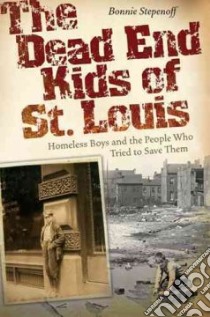The Dead End Kids of St. Louis - 9780826218889
Un libro in lingua di Bonnie Stepenoff edito da Univ of Missouri Pr, 2010
- € 31.90
- Il prezzo è variabile in funzione del cambio della valuta d’origine
Joe Garagiola remembers playing baseball with stolen balls and bats while growing up on the Hill. Chuck Berry had run-ins with police before channeling his energy into rock and roll. But not all the boys growing up on the rough streets of St. Louis had loving families or managed to find success. This book reviews a century of history to tell the story of the “lost” boys who struggled to survive on the city's streets as it evolved from a booming late-nineteenth-century industrial center to a troubled mid-twentieth-century metropolis.
To the eyes of impressionable boys without parents to shield them, St. Louis presented an ever-changing spectacle of violence. Small, loosely organized bands from the tenement districts wandered the city looking for trouble, and they often found it. The geology of St. Louis also provided for unique accommodations—sometimes gangs of boys found shelter in the extensive system of interconnected caves underneath the city. Boys could hide in these secret lairs for weeks or even months at a stretch.
Bonnie Stepenoff gives voice to the harrowing experiences of destitute and homeless boys and young men who struggled to grow up, with little or no adult supervision, on streets filled with excitement but also teeming with sharpsters ready to teach these youngsters things they would never learn in school. Well-intentioned efforts of private philanthropists and public officials sometimes went cruelly astray, and sometimes were ineffective, but sometimes had positive effects on young lives.
Stepenoff traces the history of several efforts aimed at assisting the city's homeless boys. She discusses the prison-like St. Louis House of Refuge, where more than 80 percent of the resident children were boys, and Father Dunne's News Boys' Home and Protectorate, which stressed education and training for more than a century after its founding. She charts the growth of Skid Row and details how historical events such as industrialization, economic depression, and wars affected this vulnerable urban population.
Most of these boys grew up and lived decent, unheralded lives, but that doesn't mean that their childhood experiences left them unscathed. Their lives offer a compelling glimpse into old St. Louis while reinforcing the idea that society has an obligation to create cities that will nurture and not endanger the young.
Informazioni bibliografiche
- Titolo del Libro in lingua: The Dead End Kids of St. Louis
- Sottotitolo: Homeless Boys and the People Who Tried to Save Them
- Lingua: English
- Autore: Bonnie Stepenoff
- Editore: Univ of Missouri Pr
- Collana: Univ of Missouri Pr (Hardcover)
- Data di Pubblicazione: 24 Maggio '10
- Genere: HISTORY
- Argomenti : Homeless boys Missouri Saint Louis History Homeless boys Missouri Saint Louis Social conditions Street children Missouri Saint Louis History
- Pagine: 176
- ISBN-10: 0826218881
- EAN-13: 9780826218889


